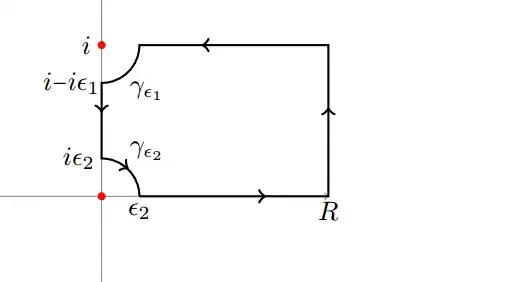$$\int_{0}^{\infty} \frac{x}{e^{x}-1}\ dx$$ Is there a way to evaluate this integral without using the zeta function?
- 10,847
- 119
- 5
-
1In some sense. You don't need to mention $\zeta(s)$ nor $\zeta(2)$, but all the known proofs are explained in the big lists for $\zeta(2) = \pi^2/6$. – reuns Jul 20 '17 at 14:53
3 Answers
METHODOLOGY $1$:
We can write
$$\begin{align} \int_0^\infty \frac{x}{e^x-1}\,dx&=\int_0^\infty \frac{xe^{-x}}{1-e^{-x}}\,dx\\\\ &=\sum_{n=0}^\infty \int_0^\infty xe^{-(n+1)x}\,dx\\\\ &=\sum_{n=1}^\infty \frac1{n^2}\\\\ &=\frac{\pi^2}{6} \end{align}$$
METHODOLOGY $2$:
Enforcing the substitution $x=-\log(1-u)$ reveals
$$\begin{align} \int_0^\infty \frac{x}{e^x-1}\,dx&=-\int_0^1 \frac{\log(1-u)}{u}\,du\\\\ &=\text{Li}_2(1)\\\\ &=\frac{\pi^2}{6} \end{align}$$
METHODOLOGY $3$:
If one doesn't like either of the first two methodologies, then one can proceed as follows. Begin as in Methodology $2$ and enforce the substitution $x=-\log(1-u)$.
$$\begin{align} \int_0^\infty \frac{x}{e^x-1}\,dx&=-\int_0^1 \frac{\log(1-u)}{u}\,du\\\\ &=\int_0^1\int_0^1 \frac{1}{1-xy}\,dx\,dy\tag 1 \end{align}$$
Then, in THIS ANSWER, I evaluated the double integral in $(1)$ by using the transformation $x=s+t$ and $y=s-t$. This facilitates using real analysis only, and without appealing to special functions to arrive at
$$\int_0^1\int_0^1 \frac{1}{1-xy}\,dx\,dy=\frac{\pi^2}{6}$$
as was to be shown!
- 179,405
-
1
-
1@SimplyBeautifulArt Well, thank you! I'm sure that there is another way. I actually prefer the third methodology here since it circumvents appeal to special functions or a priori knowledge that $\sum_{n=1}^\infty \frac1{n^2}=\frac{\pi^2}{6}$. Interestingly, the methodology was introduced in 1983 by Tom Apostle. – Mark Viola Jul 20 '17 at 15:53
-
-
-
By Means of Complex Analysis
We prove the general formula
$$\int^\infty_0 \frac{\sin(ax)}{e^{2\pi x}-1}\,dx = \frac{1}{4}\coth\left(\frac{a}{2} \right)-\frac{1}{2a}$$
Which can be used to generate many values by differentiation with respect to $a$ By integrating the following function
$$f(z) = \frac{e^{iaz}}{e^{2\pi z}-1}$$
The function is analytic in and on the contour, indented at the poles of the function
Hence by the residue theorem
$$\int_{\gamma_{\epsilon_2}}f(z)\,dz+\int^R_{\epsilon_2}f(x)\,dx+\int^{R+i}_{R}f(x)\,dx\\+\int_{R+i}^{i+\epsilon_2}f(x)\,dx+\int_{\gamma_{\epsilon_1}}f(z)\,dz-\int^{i-i\epsilon_1}_{i\epsilon_2}f(x)\,dx=0$$
Let us first look at with $ R \to \infty $
\begin{align}\left|\int_{R}^{R+i} \frac{e^{iax}}{e^{2\pi x}-1} \,dx\right| &=\left|iR\int^1_0\frac{e^{ia(R+ixR)}}{e^{2\pi (R+ixR)}-1} \,dx\right| \\&\leq R\int^1_0\frac{|e^{ia(R+ixR)}|}{|e^{2\pi (R+ixR)}-1|} \,dx \\&\leq \frac{R}{|e^{2\pi R}-1|} \int^1_0 e^{-axR} \,dx \\&= \frac{1}{a|e^{2\pi R}-1|} (1-e^{-aR}) \sim_{\infty} 0\end{align}
The next integral can be reduced to \begin{align} \int^{i(1-\epsilon_1)}_{i\epsilon_2}\frac{e^{iax}}{e^{2\pi x}-1} \,dx &= i \int^{(1-\epsilon_1)}_{\epsilon_2}\frac{e^{-ax}}{e^{2\pi i x}-1} \,dx \\&= \frac{1}{2}\int^{(1-\epsilon_1)}_{\epsilon_2}\frac{e^{-ax}}{\sin(\pi x) e^{i\pi x}} \,dx \\ &= \frac{1}{2}\int^{(1-\epsilon_1)}_{\epsilon_2}\frac{e^{-ax}}{\sin(\pi x) e^{i\pi x}} \,dx \\ &= \frac{1}{2}\int^{(1-\epsilon_1)}_{\epsilon_2}\frac{\cos(\pi x)}{\sin(\pi x) }e^{-ax} \,dx-\frac{i}{2}\int^{(1-\epsilon_1)}_{\epsilon_2}e^{-ax} \,dx\end{align}
Since the first integral diverges when $ \epsilon_1,\epsilon_2 \to 0 $
$$ PV\int^{i}_{0}\frac{e^{iax}}{e^{2\pi x}-1} \,dx =PV \int^{1}_{0}\frac{\cos(\pi x)}{2\sin(\pi x) }e^{-ax} \,dx-i\frac{1-e^{-a}}{2a} $$
The remaining integrals can be evaluated using residues $$\lim_{\epsilon_2 \to 0} \int_{\gamma_{\epsilon_2}}f(z)\,dz = -\frac{\pi i}{2}\mathrm{Res}(f,0)= -\frac{i}{4}$$
$$\lim_{\epsilon_1 \to 0} \int_{\gamma_{\epsilon_1}}f(z)\,dz = -\frac{\pi\,i}{2}\mathrm{Res}(f,i)= -\frac{i}{4}e^{-a}$$
By combining the results together
$$PV\int^\infty_{0}\frac{e^{iax}}{e^{2\pi x}-1}\,dx -PV\int^\infty_{0}\frac{e^{ia(x+i)}}{e^{2\pi (x+i)}-1}\,dx \\-PV \int^{1}_{0}\frac{\cos(\pi x)}{2\sin(\pi x) }e^{-ax} \,dx+i\frac{1-e^{-a}}{2a} = i\frac{e^{-a}+1}{4}$$
Which reduces to
$$(1-e^{-a})PV\int^\infty_{0}\frac{e^{iax}}{e^{2\pi x}-1}\,dx -PV \int^{1}_{0}\frac{\cos(\pi x)}{2\sin(\pi x) }e^{-ax} \,dx = i\frac{e^{-a}+1}{4}-i\frac{1-e^{-a}}{2a}$$
By equating the real part
$$\int^\infty_0 \frac{\sin(ax)}{e^{2\pi x}-1}\,dx = \frac{1}{4}\coth\left(\frac{a}{2} \right)-\frac{1}{2a}$$
Now by differentiation and letting $a \to 0 $
$$\int^\infty_0 \frac{x}{e^{2\pi x}-1}\,dx = \frac{1}{24}$$
Then the result follows by $y = 2\pi x$.
- 14,343
-
I would mention with $f(z) = \frac{z^{-2}}{e^{z}-1}-\frac{1}{12 z}$ then $$\frac{1}{2i\pi}\int_{|z| = 2\pi (N +1/2)} f(z) dz= \sum_{n= -N,n \ne 0}^N Res(f(z),2\pi n) = \frac{1}{2\pi^2} \int_0^\infty x \frac{1-e^{-Nx}}{e^x-1}dx$$ Letting $N \to \infty$ yields the desired result. – reuns Jul 22 '17 at 00:28
-
-
1+1 ... It's always great to see contour integration used to solve real analysis problems. – Mark Viola Jul 22 '17 at 00:37
-
-
@ZaidAlyafeai What do you mean ? $ \frac{2i \pi z^{-2}}{e^{2i \pi z}-1} = \sum_{n=-\infty}^\infty \frac{1}{z^2(z-n)}$. And I meant $f(z) = \frac{2i \pi z^{-2}}{e^{2i \pi z}-1} + \frac{1}{12 z}$ or something like that – reuns Jul 22 '17 at 03:23
-
-
It is $\frac{-Res(f,0)}{z} = \frac{-B_3/3!}{z}$ the Bernouilli number, and the same argument applied to $\frac{z^{-2k}}{e^z-1}+\frac{B_{2k+1}/(2k+1)!}{z}$ works for evaluating $\zeta(2k)$ and $\int_0^\infty \frac{x^{2k-1}}{e^x-1}dx$ – reuns Jul 22 '17 at 04:09
-
$$\text{ if } L(f) = F(s) \implies \int_0^{\infty} \frac f{e^t-1}dt = \sum_{s\ge1} F(s)$$ $$L(t) =\frac 1{s^2}\implies\int_0^{\infty} \frac t{e^t-1}dt = \sum_{s\ge1}\frac 1{s^2} = \zeta(2) $$
